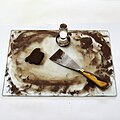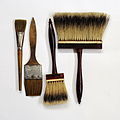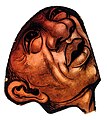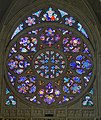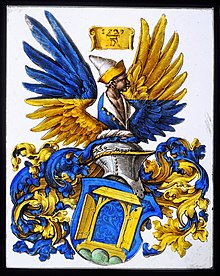Stained glass
Under glass painting is today understood primarily the production of colored window with pictorial representations. In the High Middle Ages, the monastery windows of the Cistercian abbeys were also made using the grisaille technique (gray and white). The effect is created by the light shining through. Glass painting has a special place in painting because no other type of painting can show such a high level of color luminosity and such great differences in brightness as a transparent glass picture . Contrast range and color brilliance are even stronger than with a slide compared to a paper photo. The blaze of color creates a mystical to solemn mood and is therefore mainly used in the sacred area. As part of large works, glass painting serves architecture .
A completely different kind is the reverse glass painting , which only in the supervision is considered.
technology
Two basic techniques are used:
- Only the drawing is applied to colored glass using black solder , which can also be used to create shadow and light effects.
- Colorless or monochrome glasses are painted with enamel paints that develop the desired color when fired.
Further effects are created by working on colored real antique glasses before painting. Overlapped glasses , consisting of a colorless carrier and a colored top layer, are suitable for engraving , etching and sandblasting , among other things . The colored glass layer is partially removed. For etching you need hydrofluoric acid , which produces different levels of brightness depending on the duration of exposure.
The glass painter first applies the contours to the front of the glass with a brush. The colored enamel colors are floating on the back or distributed smoothly. He achieves shades of gray by first painting the pane with coating paint, distributing it evenly and, after drying, using various erasing and wiping techniques . With a brush handle, a pointed stick or a goose quill you can achieve light edges, damasks and chasings. The color can also be sprayed on, applied with kerosene or turpentine or, in the case of series production, applied using screen printing oil.
A special feature are the grisaille windows, which were created from the 13th century onwards . White, gray, light yellow and gray-green glasses are put together either bare or with black solder or silver yellow painting. Examples of this painting from the 13th and 14th centuries can be seen in the Cistercian Church in Altenberg near Cologne.
Stained glass paints are baked in an oven at 550 ° C to 640 ° C. In churches, the effects of the weather often require protective glass, as sintering, bird droppings, condensation, acid rain and exhaust gases can destroy or damage the painting.
material
A distinction is made between hand-blown and machine-made glass . The first includes real antique glass, real antique overlaid glass, new antique glass, Goethe glass , cathedral glass, opalescent glass and Danziger glass (Stromglas), which has a particularly strong streak structure. Ornamental glass and float glass are produced by machine.
Panes painted with black solder have been preserved since the 8th century . Black solder is the name for a mixture of ground glass (glass flux) and copper or iron oxide. It is used for contouring and labeling or for surface painting.
In the 14th century, the use of transparent silver yellow , a mixture of carbonate of silver and ocher earth, began to be used. It is the only color of glass in which the silver penetrates into the glass when it is fired and turns it yellow in contrast to the other enamel colors, which only combine with the surface. After the fire, the brownish earth remains on the surface of the glass as a brown layer and is washed off or etched off with diluted hydrofluoric acid. It was mostly used for crowns, halos, hair, coats of arms and clothing. Silver yellow results in shades from light lemon yellow to dark brown. The color palette was supplemented in the 15th century by iron red for meat parts and ornaments.
In the 16th century enamel colors , also called enamel colors , were invented. They consist of powdered glass, lead and pigments (metal oxides) such as iron, copper, tin and chromium oxides as well as sulphides and selenium. They often contain toxic heavy metals. Due to the strict regulations of the new environmental law, they now contain fewer pollutants, but are of poor quality. Matt white has the property that it lights up brightly when applied over a large area. This effect is particularly strong when there is sidelight from the back against a dark background. At 640 ° C, enamel colors fuse with the glass and become part of it. Removal is only possible by grinding, etching or sandblasting. As the binder is gum arabic used in water color and vinegar and oil thickness in turpentine.
Tool
A glass palette , spatula and runner are required to rub the colors on . The glass painter mixes the colored powder with a little gum arabic and water and rubs it with the runner to a fine-grained, smooth mass. He places the disc to be painted on a transparent table easel , puts it on a light table or on the 1: 1 template . A contour board is used to support the forearm and thereby keep the painting hand steady.
The artisan needs different brushes to paint. With the coating brush ( painter ) he spreads the coating on and spreads it evenly with the expeller made of soft badger hair. A cowhair brush with long hair, called a half- tractor , is used to contour and apply the bright colors. Eraser brushes are bristle brushes of different sizes , the hair length of which the glass painter usually shortens in order to make it stiffer. The stippling brush enables surfaces to be lightened.
The glass painter wipes light spots from the soft cover with his finger, for example to depict clouds or light and shadow effects. With the eraser brush he can erase lighter details more precisely. Sticks , goose quills or steel nibs are used to erase fine lines and add lights. Hydrofluoric acid is required to etch flashed glass. Gloves and respiratory protection are necessary because of the dangerous fumes.
Sacred windows
The origin of stained glass is likely to be in Sassanid Persia . As early as the 1st century AD, the Romans used panes of glass and glass mosaics in their thermal baths to provide brightness and maintain the warmth in the rooms. There were also glass windows in the houses of the rich. However, stained glass is mainly found in the sacred area. Five glazed windows in Hagia Sophia in what was then Constantinople have been preserved from the 6th century, as well as windows from the Basilica of St. Vicentius in Paris and a round pane with a blessing Christ from the church in San Vitale in Ravenna. In the 7th century many churches were built in Europe and decorated with glass paintings, for example in Bourges and York. At Jericho, remnants of stained glass from the 8th century with ornamental motifs were found.
As one of the first sacred buildings, St. Denis near Paris was decorated with figural glass paintings in the 9th century, as did the cathedrals of Liège, Auxerre and Reims around the same time. The oldest fully preserved figural windows are the five prophet windows in Augsburg Cathedral , which were probably created in the late 11th century as part of a more extensive cycle. Three fragments were claimed for the time before the prophet windows: the Schwarzacher head (around 1000, from Schwarzach Monastery , on loan from the Badisches Landesmuseum Karlsruhe), the head of a saint from Lorsch Monastery (mid-11th century, previously dated around 1000, Hessisches Landesmuseum Darmstadt) and the head of Christ from the monastery church Weissenburg in Alsace (around 1060/1070 or late 12th century, women's shelter museum Strasbourg).
The first great heyday of stained glass is the Gothic , especially in the French cathedrals, where it was part of the overall concept. From 1215 to 1240, 176 windows were made in Notre-Dame de Chartres . Stories from the Bible and legends of saints are told in bright colors over an area of 2000 m². Glass paintings in St. Martin in Colmar, in the Sainte-Chapelle in Paris, in Notre-Dame de Paris , in Amiens, Bourges, Reims, Rouen, Le Mans and Strasbourg date from the 13th century . In the middle of the 15th century, Peter Hemmel von Andlau created the Strasbourg style here and made church windows throughout Central Europe. The cathedral of Metz has the largest glass window area of the French cathedrals (6000 m²), including by Hermann von Münster (late 14th century), Thiebaut von Lixheim (1504), Valentin Bousch from Strasbourg (1521–1539) and Marc Chagall (1960).


In Germany there are Gothic church windows in Cologne Cathedral , Augsburg Cathedral , Freiburg Cathedral , Regensburg Cathedral , Ulmer Münster , Erfurt Cathedral , St. Paulus Cathedral in Münster, the Frauenkirche in Munich and St. Lorenz in Nuremberg. There was Veit Hirschvogel the leading glassmakers and worked from 1500 with Albrecht Dürer together, who designed it, the Bamberger window in St. Sebald created.
St. Andrew's Cathedral in Wells, York Minster, and the Salisbury, Winchester, and Oxford cathedrals contain examples of medieval glass art in England. In Switzerland you can find important windows from the 13th to 15th centuries in the former Königsfelden monastery , in the Bern Minster and in the Notre Dame cathedral in Lausanne. In Austria, St. Stephen's Cathedral in Vienna, the parish church of Steyr and Klosterneuburg Abbey are known for their sacred windows.
The sober furnishing of churches after the Reformation caused a break in glass production and processing. Even before and during the Thirty Years' War, glass production and thus glass painting also came to a standstill. In the baroque era, churches and living rooms were bright and flooded with light, in keeping with the taste of the time, and therefore mostly not equipped with colored glazing.
It was not until the beginning of the 19th century that stained glass experienced a second heyday until the beginning of the 20th century. King Ludwig I promoted the establishment of workshops in Munich, but glass painting companies were also founded in Benediktbeuern, Goch, Kevelaer, Düsseldorf, Cologne, Linnich, Zittau, Berlin and Innsbruck. Around 1870 churches were built in the neo-Gothic style, for which many new constructions were required. After the First World War, it was necessary to repair war damage and to restore or replace glass windows. At the turn of the century, Louis Comfort Tiffany became known in America for his glass windows and lamps and in Lorraine, Émile Gallé for his new glass processing techniques. During this Art Nouveau period , cathedral glass and ornamental glass were often used, as was the opalescent glass with metallic shimmering, invented by Tiffany.
The damage caused by the Second World War led to a large number of new stained glass and leaded glazing , which were mainly made during the 1950s and 1960s. Two hundred Chartres-style windows were designed by Franz XW Braunmiller and Karl Jung in 1953 for the cathedral in Newark, New Jersey . Many other painters designed church windows in the 20th century, including Georges Braque , Marc Chagall , Fernand Léger , Henri Matisse , Joan Miró , Georges Rouault , Georg Meistermann , Hans Gottfried von Stockhausen and Josef Oberberger . In the last two decades of the 20th century, more and more reconstructions of older stained glass could be observed, which replaced modern glazing. One example of this is Cologne Cathedral .
Profane windows

There have been many examples of stained glass from the secular area since the late Middle Ages. Castles and noble residences were equipped with it. More recently Johann Jacob Kellner copied a Dürer woodcut with St. Sebald on glass for Hohenschwangau Castle in 1836 . Wilhelm I, King of Württemberg, had a villa and garden complex built in the Moorish style near Bad Cannstatt decorated with naturalistic glass pictures by Carl Johann Wetzel in 1855. Some of them go back to paintings by Titian , such as the Venus de Urbino from the Uffizi Gallery in Florence.
But the citizens who had become wealthy also ordered artistic glazing for the halls, stairwells and private chapels of their houses, such as the Tucher merchant family in Nuremberg. The original windows from the 16th century with figures from Greek and Roman mythology can still be found in the splendidly furnished Tucherhaus. In the 19th century, stained glass was a popular decoration in town houses, which were not only decorative but also obscured unsightly views.
Guild rooms and restaurants ordered coats of arms, brewery and craftsmen disks as well as city views for their rooms. Examples from the 20th century are 25 windows and glazing designed by Max Lacher in 1974 in the Hackerkeller in Munich with Bavarian motifs and slogans in the Blue Grass restaurant in Cleveland, Ohio, where a popular sport, for example football, is represented in each pane .
In 1900 Fritz Geiges painted windows for the New Town Hall in Freiburg im Breisgau , on which Berthold Schwarz , the supposed inventor of gunpowder, can be seen. The New Town Hall in Munich contains many glass paintings with themes from the city's history. Glass art can also be found in banks, indoor swimming pools and department stores. Marc Chagall designed a large window with peace motifs for the UN building in New York. An electric mosaic with stained glass by Gyorgy Kepes decorates the wall of KLM's flight ticket office in New York. It is illuminated with flashing lights and is thematically reminiscent of space. Even schools have been fitted with glass windows. The Fables of Aesop (1867) are depicted in the stairwell of Rendcomb College, England. In the 20th century Orin E. Skinner painted 24 scenes from the Grimm Brothers' fairy tales for the German classroom at the University of Pittsburgh.
The newly awakened interest in glass painting in the 19th century is evident in the diverse and innovative exhibits at world exhibitions. In 1851, glass art by 24 companies and individuals was shown in Sir Joseph Paxton's Crystal Palace in London . At the world exhibition in Vienna in 1873, a Munich glass painting company won first prize for a medallion window in a completely classic style. The 1893 World's Fair in Chicago shone with a chapel made of millions of pieces of glass. A painted glass wall was designed for the German Pavilion at the World Exhibition in Montreal in 1967.
Cabinet disks
Until the 13th century, the motifs of small glass panes were the Christian message of salvation, the Passion of Christ, the life of Mary and the legends of the saints. In churches, profane themes were accommodated in the tracery, in the edge strips and in the base zone. Mostly they were donor and craftsman figures. From the middle of the 15th century, attractive quatrefoil discs were created , for example the two discs from the Augsburg circle around Jörg Breu the Elder. Ä. (since 2000 in the Germanisches Nationalmuseum Nürnberg, MM 898 and 899), perhaps a present for King Ferdinand I.
In the case of cabinet panels for secular buildings, the painting style was designed to be able to see them up close and at eye level. Most of the time, they were not designed for a specific room and therefore movable and interchangeable. They were almost always gifts and were often collected because of their handy size. They were often made in small series, for example as copies of woodcuts and engravings by the painters Albrecht Dürer and Hans Holbein the Younger . The predominance of the bourgeoisie and peasantry over the nobility and clergy determined the themes in the Middle Ages. The struggle of virtues and vices for the human soul or the seven liberal arts were often depicted. Seasons, pictures of the month, signs of the zodiac, works of mercy, Greek and Roman myths, emperors and kings were popular motifs. Heraldry took up a large area from the 16th century. Mythical creatures like dragons, griffins or centaurs were depicted as well as wild men, jugglers and fools, merchants or death. Scenes from popular life showed craftsmen such as bricklayers, bakers, money changers or blacksmiths, but also hunting scenes, soldiers, sieges, carriage rides and city views.
The Swiss discs in particular had a high artistic level. Weddings, baptisms and coats of arms of noble families, cities, guilds, citizens and farmers are depicted on it. Cantons and cities exchanged coats of arms. The Zurich glass painters Christoph Murer , Hans Rütter and Lukas Zeiner have become known beyond the borders of Switzerland .
Beer disks were painted in a fresh and naive way, especially in northern Germany. Her subjects are professions such as butcher, beekeeper, potter, teacher or cook. You can see riders, hikers and bagpipe pipers, women embroidering and spinning or with a welcome drink in hand. Other motifs were sailing ships, birds, trees and landscapes.
See also
- List of stained glass painters
- List of stained glass workshops
- Glass museum
- Leaded glass window
- Corpus Vitrearum Medii Aevi
literature
- Stained glass . In: Meyers Konversations-Lexikon . 4th edition. Volume 7, Verlag des Bibliographisches Institut, Leipzig / Vienna 1885–1892, p. 401.
- Rüdiger Becksmann (ed.): German glass painting of the Middle Ages. Volume 1: Requirements, developments, connections. Deutscher Verlag für Kunstwissenschaft, Berlin 1995, ISBN 3-87157-161-X .
- Johannes Ralf Beines: Materials on the history of colored glazing from 1780 to 1914, preferably for the area of the Federal Republic of Germany. In: Landeskonservator Rheinland (Hrsg.): Colored windows in Bonn houses (= Landeskonservator Rheinland. Workbooks. 24: Technical monuments. ). Rheinland-Verlag u. a., Cologne 1979, ISBN 3-7927-0333-5 , pp. 81-217 (Bonn, University, dissertation, 1979).
- Hans-Rainer Bernhardt, Guido Andelfinger: Working with colored glass. A manual for fine art glazing and stained glass. Kunstverlag Weingarten, Weingarten 2000, ISBN 3-8170-2034-1 .
- Eva Frodl-Kraft: The glass painting. Development, technology, individuality. Anton Scholl & Co., Vienna a. a. 1970.
- Louis Grodecki : Romanesque stained glass . Kohlhammer Verlag, Stuttgart 1977, ISBN 3-17-004433-8 .
- Gottfried Heinersdorff : The glass painting, its technology and its history. With an introduction and an appendix on modern glass painting by Karl Scheffler . Bruno Cassirer, Berlin 1914.
- Annette Jansen-Winkeln (Ed.): Artist between the times. 11 volumes. Wissenschafts-Verlag für Glasmalerei, Eitorf 1983-2006, ZDB -ID 2287921-3 .
- Lawrence Lee, George Seddon, Francis Stephens: The World of Stained Glass Windows. Twelve centuries of occidental glass painting in over 500 color pictures. Orbis-Verlag, Munich 1992, ISBN 3-572-00524-8 .
- Andrew Moor: Architecture - Glass - Color. Contemporary examples. Deutsche Verlags-Anstalt, Munich 2006, ISBN 3-421-03579-2 .
-
Heinrich Oidtmann : The glass painting. Presented in a generally understandable way. Bachem, Cologne 1892–1898;
- Part 1: The technique of stained glass. 1892;
- Part 2, 1: The early period up to the year 1400. 1898.
- Erhard Remmert: Art Nouveau windows in Germany. 3rd, revised edition. Kunstverlag Weingarten, Weingarten 1996, ISBN 3-8170-2028-7 .
- Erich Stephany u. a .: New glass painting in Germany. Schnell & Steiner, Munich 1963.
- Sebastian Strobl: Glass technology of the Middle Ages. Gentner, Stuttgart 1990, ISBN 3-87247-402-2 (At the same time: Cologne, University, dissertation, 1989: Manufacture and processing of flat glass in the Middle Ages. ).
- Hans Wentzel (ed.): Masterpieces of glass painting. 2nd, improved edition. German Association for Art History, Berlin 1954.
- Elisabeth von Witzleben: Painted panes of glass. Folk life on cabinet and beer slices. Georg DW Callwey, Munich 1977, ISBN 3-7667-0408-7 .
Web links
- Research Center for 20th Century Glass Painting Foundation V. Mönchengladbach
- Image archive on medieval stained glass
- The technique of stained glass.
Individual evidence
- ↑ The dating varies between around 1080 and 1200: Elisabeth von Witzleben: Die Prophetenfenster in Augsburg Cathedral . In: Richard Binder, Norbert Lieb , Toni Roth (eds.): The cathedral in Augsburg . 2nd Edition. Verlag multi-druck J. Hannesschläger, Augsburg 1966, DNB 456478205 , p. 27–30, here p. 30 : “around 1140” . - Likewise: Herbert Schindler : Great Bavarian Art History . Volume 1: Early and Middle Ages . Süddeutscher Verlag, Munich 1963, p. 155–156 : "around 1140" . - Anton von Euw: Window with the prophets David and Hosea . In: Hermann Fillitz (Ed.): The Middle Ages I (= Propylaea Art History . Volume 5 ). Propylaeen-Verlag, Berlin 1969, p. 263 with color plate XLIV : “1. Third of the 12th century ” - Gottfried Frenzel: Glass painting . In: Suevia sacra. Early art in Swabia . Exhibition (...). 3. Edition. Augsburg 1973, DNB 730519813 , p. 221–224 : “End of the 11th century” - Alexander von Reitzenstein , Herbert Brunner: Bayern Süd. Upper Bavaria, Lower Bavaria, Swabia. Art monuments and museums (= Reclams Art Guide Germany . Volume I, 1). 9th edition. Philipp Reclam jun., Stuttgart 1983, ISBN 3-15-010317-7 , pp. 56 : "Incunabula of German glass painting from around 1100" . - Norbert Lieb, Werner Schnell: The cathedral in Augsburg (= Paul Mai [Hrsg.]: Schnell, art guide . No. 64 ). 22nd edition. Schnell & Steiner, Munich / Zurich 1985, p. 14 : “(...) these windows, which represent the oldest (fragmentary) surviving cycle in the world, are among the most important examples of early medieval glass art. The dating is between the end of the 11th century and 1200. ” - Bruno Bushart , Georg Paula (editor): Bayern III: Schwaben (= Georg Dehio [founder], Dehio Association [publisher]: Handbook of German Art Monuments ). Deutscher Kunstverlag, Munich / Berlin 1989, ISBN 978-3-422-03008-4 , pp. 53 : "(...) closest to Hirsau book paintings from the early 12th century (...)" . - Karlheinz Knebel: The high cathedral in Augsburg. In: Website of the Diocese of Augsburg. Retrieved on March 20, 2020 : "five prophet windows from the oldest cycle of stained glass in the world, late 11th century."
- ^ Rüdiger Becksmann: Glass painting find from Schwarzach Monastery . In: Yearbook of the State Art Collections in Baden-Württemberg . tape 44 . Deutscher Kunstverlag, Munich / Berlin 2007, ISBN 978-3-422-06710-3 , pp. 131–132 with Fig. 1 : “(...) the unique Schwarzacher Köpfchen (...), whose classification in the period around 1000 has been unchallenged since 1970. After the recent re-dating of the Lorsch head in the middle of the 11th century and the Weißenburg head in the late 12th century, the Schwarzacher head may even be considered the oldest evidence of figural glass painting in Europe. ” - Earlier dating of the Weißenburg head: Florens Deuchler, Jean Wirth: Alsace. Art monuments and museums (= Reclams Art Guide France . Volume II ). 1st edition. Philipp Reclam jun., Stuttgart 1980, ISBN 3-15-010297-9 , pp. 264–265 : "(...) the oldest surviving occidental piece of glass painting ever, made around 1070 (...)" .
- ^ Daniel Hess: King Ferdinand I and the judgment of Paris. Two newly acquired four-pass discs from the Jörg Breus district. In: Anzeiger des Germanisches Nationalmuseum. 2001, ISSN 1430-5496 , pp. 125-136.





